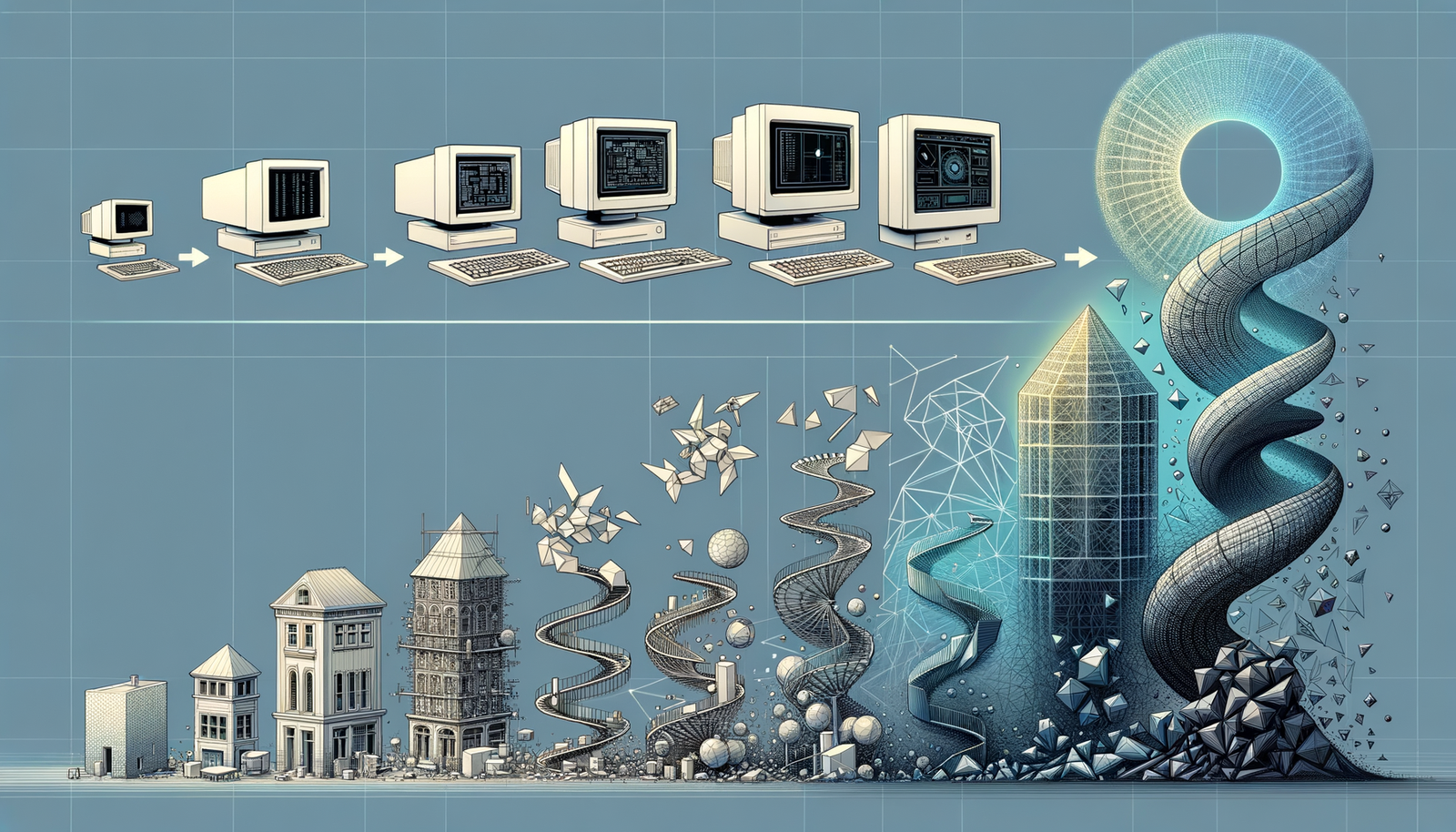Your Cart is Empty
Customer Testimonials
-
"Great customer service. The folks at Novedge were super helpful in navigating a somewhat complicated order including software upgrades and serial numbers in various stages of inactivity. They were friendly and helpful throughout the process.."
Ruben Ruckmark
"Quick & very helpful. We have been using Novedge for years and are very happy with their quick service when we need to make a purchase and excellent support resolving any issues."
Will Woodson
"Scott is the best. He reminds me about subscriptions dates, guides me in the correct direction for updates. He always responds promptly to me. He is literally the reason I continue to work with Novedge and will do so in the future."
Edward Mchugh
"Calvin Lok is “the man”. After my purchase of Sketchup 2021, he called me and provided step-by-step instructions to ease me through difficulties I was having with the setup of my new software."
Mike Borzage
Design Software History: The Evolution and Impact of Parametric Modeling in Design Software History
November 27, 2024 6 min read


Introduction to Parametric Modeling
Parametric modeling has revolutionized the way designers and engineers approach product development in the modern era. By allowing the creation of models that can be easily modified through the adjustment of parameters, it has introduced a level of flexibility and efficiency previously unattainable. Parametric modeling's significance in modern design lies in its ability to streamline the design process, reduce errors, and facilitate rapid iterations. This modeling approach enables designers to focus on optimizing the functionality and aesthetics of a product, knowing that changes can be propagated throughout the model seamlessly. The integration of parametric design into software tools has empowered industries ranging from automotive to aerospace, fundamentally altering the landscape of product development.
The origins of parametric design can be traced back to the need for more dynamic and adaptable design methods. In the early days of computer-aided design (CAD), models were static and any modification required substantial rework. The foundational concept of parametric design emerged as a solution to this rigidity, introducing parameters as variables that define the characteristics of a model. By linking these parameters to the geometry of the design, changes in one aspect of the model could automatically update related features. This innovation was a significant departure from traditional CAD methods, laying the groundwork for a new era of design where adaptability and responsiveness became core principles.
Several key figures and companies played pivotal roles in the development of parametric modeling technology. Among them, Dr. Samuel P. Geisberg stands out as a visionary who recognized the potential of parametric design. As the founder of Parametric Technology Corporation (PTC) in 1985, Geisberg led the charge in bringing parametric modeling to the forefront of design software. PTC's introduction of Pro/ENGINEER, the first commercially successful parametric, feature-based, solid modeling CAD software, marked a turning point in the industry. Other companies like Dassault Systèmes, with their CATIA software, and Autodesk, with products like Inventor, also contributed to the advancement and proliferation of parametric modeling tools, ensuring that the technology became a standard in various design disciplines.
The Rise of PTC's Pro/ENGINEER in the 1980s
The 1980s witnessed a significant leap in design software innovation with the introduction of Pro/ENGINEER by Parametric Technology Corporation (PTC). Pro/ENGINEER was groundbreaking for its time, being the first CAD software to fully implement parametric, feature-based, solid modeling capabilities. Its groundbreaking features included a user-friendly interface, the use of parameters to define design intent, and the ability to create complex assemblies with interrelated components. This software allowed engineers to define relationships between different elements of a design, so that modifications to one part would automatically adjust related parts, preserving the overall integrity of the design. This level of automation and integration was unprecedented and set a new benchmark for CAD software.
Pro/ENGINEER fundamentally changed industry standards by introducing a new paradigm in product design and development. Prior to its introduction, designers relied on 2D drafting and non-parametric 3D modeling, which were time-consuming and error-prone when changes were required. With Pro/ENGINEER, the adoption of parametric modeling meant that designs could be iterated more rapidly, with increased accuracy and consistency. This shift led to significant reductions in product development cycles and costs. Industries began to standardize on parametric modeling as best practice, recognizing the value it brought in terms of efficiency and competitiveness. The ripple effect of Pro/ENGINEER's impact extended beyond software, influencing organizational processes and strategies in product development.
The influence of Pro/ENGINEER and PTC was further solidified as numerous companies adopted the software to enhance their design capabilities. While we are not mentioning specific case studies, it is noteworthy that early adopters spanned a range of industries, from automotive giants to consumer electronics manufacturers. These companies experienced firsthand the advantages of parametric modeling, such as improved collaboration among engineering teams, reduced time-to-market for new products, and the ability to maintain design intent throughout the product lifecycle. The widespread acceptance of Pro/ENGINEER established parametric modeling as an indispensable tool in modern engineering and design.
Advancements in Parametric Modeling Techniques
As technology progressed, contemporary tools and methodologies in parametric design have evolved to meet increasingly complex design challenges. Modern parametric modeling software incorporates advanced features such as constraint-based modeling, where relationships between geometric entities are defined through mathematical constraints. This allows for more precise control over design parameters and enhances the robustness of models. Additionally, integration with simulation tools enables designers to test and validate designs within the same environment, streamlining the development process. Software such as SolidWorks, Siemens NX, and Autodesk Fusion 360 represent the evolution of parametric design tools, offering comprehensive solutions that cater to the multifaceted needs of today's designers and engineers.
One of the most significant advancements enhancing traditional parametric techniques is the incorporation of generative design. Generative design uses algorithms and computational power to generate optimized design solutions based on specified constraints and objectives. This approach leverages artificial intelligence and machine learning to explore a vast design space, producing innovative solutions that might not be intuitive to human designers. Generative design enhances parametric modeling by introducing an element of automated creativity, where the software suggests optimal configurations based on parameters such as weight reduction, material efficiency, or structural integrity. This synergy between parametric modeling and generative design tools is pushing the boundaries of what is possible in product development.
When comparing parametric modeling to direct modeling approaches, several distinctions emerge. Parametric modeling is characterized by the use of parameters and a history tree that records the sequence of modeling operations. This allows for precise control and easy modification of the model by adjusting parameters. In contrast, direct modeling involves manipulating the geometry of the model directly without the constraints of a history tree or parameters. The key differences can be summarized as:
- Parametric Modeling: Uses parameters and constraints; ideal for complex designs requiring precise control; changes propagate throughout the model.
- Direct Modeling: Geometry is edited directly; more flexible for rapid changes; lacks a history tree which can limit the ability to make systematic modifications.
Designers often use a combination of both approaches, utilizing parametric modeling for initial design and direct modeling for modifications and iterations. The choice between the two depends on the specific requirements of the project, with parametric modeling offering advantages in projects that benefit from parameter-driven adjustments and direct modeling providing speed and ease of use in certain contexts.
Conclusion
In summary, the evolution of parametric modeling has had a profound impact on the field of design software. From its origins as a solution to the limitations of early CAD systems, parametric modeling has grown into a fundamental technology that underpins modern design practices. The introduction of Pro/ENGINEER by PTC in the 1980s marked a significant milestone, bringing parametric, feature-based modeling to the forefront and changing industry standards. The advancements in parametric modeling techniques, including the integration of generative design, have further enhanced the capabilities of designers and engineers. Parametric modeling's significance in design software history is undeniable, having transformed the way products are conceptualized, developed, and brought to market.
Looking to the future, parametric modeling is poised to continue its impactful role across various industries such as architecture, engineering, and manufacturing. In architecture, parametric design enables the creation of complex, organic structures that were previously difficult to conceptualize and construct. In engineering and manufacturing, the ongoing integration of parametric modeling with additive manufacturing technologies, like 3D printing, offers new opportunities for innovation and efficiency. The potential impact includes:
- Customization: Ability to tailor products to individual specifications on a large scale.
- Material Efficiency: Optimization of designs to minimize material usage without compromising performance.
- Innovation: Exploration of novel design geometries that were not possible with traditional methods.
For designers and engineers, exploring the benefits of parametric modeling in their work is not just an option but a necessity to stay competitive in today's fast-paced environment. The ability to create adaptable and efficient designs, respond quickly to changes, and collaborate effectively with team members is invaluable. Embracing parametric modeling tools and methodologies can lead to significant improvements in productivity and innovation. It is a call to action for professionals in the field to invest in learning and integrating these technologies into their workflows, ensuring they are well-equipped to meet the demands of the future and continue pushing the boundaries of what is achievable in design and engineering.
Also in Design News

Cinema 4D Tip: Matrix-Driven Instancing for High-Performance Scattering
December 20, 2025 2 min read
Read More
V-Ray Tip: V-Ray Anisotropy Techniques for Brushed Metals and Hair
December 20, 2025 2 min read
Read More
Revit Tip: Revit Nested Tagging: Shared Nested Families and Roll-Up Parameters
December 20, 2025 2 min read
Read MoreSubscribe
Sign up to get the latest on sales, new releases and more …


